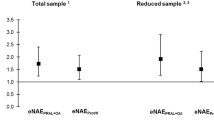Abstract
Objective:
The potential renal acid load (PRAL) in diet may have a key role in renal stone formation through its effect on calcium and citrate metabolism. We examined the association between calcium renal stone formation and the PRAL in a population-based case–control study.
Methods:
A group of 123 calcium renal stone formers was compared with an equal number of age- and sex-matched controls. Dietary history was obtained by 24-h recall. Odds ratios (ORs) and 95% confidence intervals (CI) were calculated across quartiles of dietary intakes of PRAL.
Results:
Compared with those in the lowest quartiles of PRAL, we found an increased risk of renal stone formation for those in the highest quartile (Q4 OR=2.51, 95% CI 1.218–5.172). Regarding individual food patterns, we found a significant protection for a high consumption of vegetables (two or more servings/day; OR=0.526, 95% CI 0.288–0.962).
Conclusions:
A PRAL in diet and a reduced consumption of vegetables are associated with an increased risk of calcium renal stone formation. In renal stone formers consumption of plant foods should be encouraged in order to counterbalance the acid load derived from animal-derived foods.
This is a preview of subscription content, access via your institution
Access options
Subscribe to this journal
Receive 12 print issues and online access
$259.00 per year
only $21.58 per issue
Buy this article
- Purchase on Springer Link
- Instant access to full article PDF
Prices may be subject to local taxes which are calculated during checkout
Similar content being viewed by others
References
Curhan GC, Willett WC, Rimm EB, Stampfer MJ . A prospective study of dietary calcium and other nutrients and the risk of symptomatic kidney stones. N Engl J Med 1993; 328: 833–838.
Trinchieri A, Mandressi A, Luongo P, Longo G, Pisani E . The influence of diet on urinary risk factors for stones in healthy subjects and idiopathic renal calcium stone formers. Br J Urol 1991; 67: 230–236.
Remer T, Manz F . Potential renal acid load of foods and its influence on urine pH. J Am Diet Assoc 1995; 95: 791–797.
Jacobs DR Jr, Steffen LM . Nutrients, foods, and dietary patterns as exposures in research: a framework for food synergy. Am J Clin Nutr 2003; 78 (3 Suppl), 508S–513S.
Frassetto LA, Todd KM, Morris RC Jr, Sebastian A . Estimation of net endogenous noncarbonic acid production in humans from diet potassium and protein contents. Am J Clin Nutr 1998; 68: 576–583.
Tannen RL . Effect of potassium on renal acidification and acid-base homeostasis. Semin Nephrol 1987; 7: 263–273.
Demigné C, Sabboh H, Remsey C, Meneton P . Protective effects of high dietary potassium: nutritional and metabolic aspects. J Nutr 2004; 134: 2903–2906.
Siener R, Glatz S, Nicolay C, Hesse A . The role of overweight and obesity in calcium oxalate stone formation. Obes Res 2004; 12: 106–113.
Lemann JJr, Lennon EJ, Goodman AD, Litzow JR, Relman AS . The net balance of acid in subjects given large loads of acid or alkali. J Clin Invest 1965; 44: 507–517.
Trinchieri A, Zanetti G, Currò A, Lizzano R . Effect of potential renal acid load of foods on calcium metabolism of renal calcium stone formers. Eur Urol 2001; 39 (Suppl 2), 33–36. discussion 36–7.
Trinchieri A, Lizzano R, Marchesotti F, Zanetti G . Effect of potential renal acid load of foods on urinary citrate excretion in calcium renal stone formers. Urol Res 2006; 34: 1–7.
Pak CY . Citrate and renal calculi: an update. Miner Electrolyte Metab 1994; 20: 371–377.
Mossetti G, Vuotto P, Rendina D, Numis FG, Viceconti R, Giordano F et al. Association between vitamin D receptor gene polymorphisms and tubular citrate handling in calcium nephrolithiasis. J Intern Med 2003; 253: 194–200.
Okamoto N, Aruga S, Matsuzaki S, Takahashi S, Matsushita K, Kilamura T et al. Associations between renal sodium-citrate cotransporter (hNaDC-1) gene polymorphism and urinary citrate excretion in recurrent renal calcium stone formers and normal controls. Int J Urol 2007; 14: 344–349.
Borghi L, Schianchi T, Meschi T, Guerra A, Allegri F, Maggiore U et al. Comparison of two diets for the prevention of recurrent stones in idiopathic hypercalciuria. N Engl J Med 2002; 346: 77–84.
Taylor EN, Fung TT, Curhan GC . DASH-style diet associates with reduced risk for kidney stones. J Am Soc Nephrol 2009; 20: 2253–2259.
Taylor EN, Stampfer MJ, Mount DB, Curhan GC . DASH-style diet and 24-hour urine composition. Clin J Am Soc Nephrol 2010; 5: 2315–2322.
Meschi T, Maggiore U, Fiaccadori E, Schianchi T, Bosi S, Adorni G et al. The effect of fruits and vegetables on urinary stone risk factors. Kidney Int 2004; 66: 2402–2410.
Taylor EN, Curhan GC . Fructose consumption and the risk of kidney stones. Kidney Int 2008; 73: 207–212.
Fink HA, Akornor JW, Garimella PS, MacDonald R, Cutting A, Rutks IR et al. Diet, fluid, or supplements for secondary prevention of nephrolithiasis: a systematic review and meta-analysis of randomized trials. Eur Urol 2009; 56: 72–80.
Author information
Authors and Affiliations
Corresponding author
Ethics declarations
Competing interests
The authors declare no conflict of interest.
Rights and permissions
About this article
Cite this article
Trinchieri, A., Maletta, A., Lizzano, R. et al. Potential renal acid load and the risk of renal stone formation in a case–control study. Eur J Clin Nutr 67, 1077–1080 (2013). https://doi.org/10.1038/ejcn.2013.155
Received:
Revised:
Accepted:
Published:
Issue Date:
DOI: https://doi.org/10.1038/ejcn.2013.155
Keywords
This article is cited by
-
Distal renal tubular acidosis: a systematic approach from diagnosis to treatment
Journal of Nephrology (2021)
-
Anthropometric variables, physical activity and dietary intakes of patients with uric acid nephrolithiasis
Urolithiasis (2020)
-
Nutrients, vitamins, probiotics and herbal products: an update of their role in urolithogenesis
Urolithiasis (2020)
-
Obesity and urolithiasis: evidence of regional influences
Urolithiasis (2017)
-
Dietary recommendations and treatment of patients with recurrent idiopathic calcium stone disease
Urolithiasis (2016)


